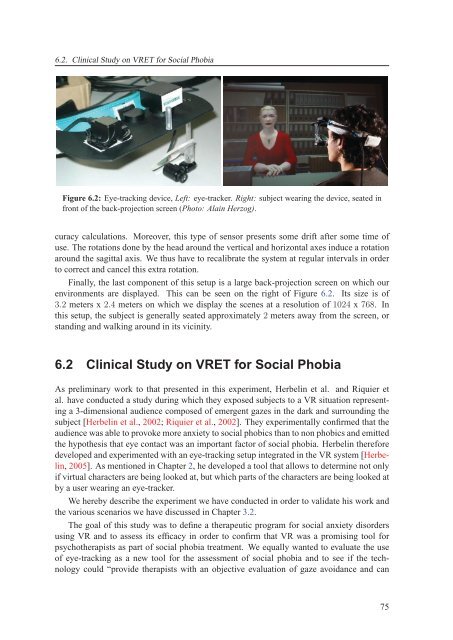Texte intégral / Full text (pdf, 20 MiB) - Infoscience - EPFL
Texte intégral / Full text (pdf, 20 MiB) - Infoscience - EPFL
Texte intégral / Full text (pdf, 20 MiB) - Infoscience - EPFL
You also want an ePaper? Increase the reach of your titles
YUMPU automatically turns print PDFs into web optimized ePapers that Google loves.
6.2. Clinical Study on VRET for Social Phobia<br />
Figure 6.2: Eye-tracking device, Left: eye-tracker. Right: subject wearing the device, seated in<br />
front of the back-projection screen (Photo: Alain Herzog).<br />
curacy calculations. Moreover, this type of sensor presents some drift after some time of<br />
use. The rotations done by the head around the vertical and horizontal axes induce a rotation<br />
around the sagittal axis. We thus have to recalibrate the system at regular intervals in order<br />
to correct and cancel this extra rotation.<br />
Finally, the last component of this setup is a large back-projection screen on which our<br />
environments are displayed. This can be seen on the right of Figure 6.2. Its size is of<br />
3.2 meters x 2.4 meters on which we display the scenes at a resolution of 1024 x 768. In<br />
this setup, the subject is generally seated approximately 2 meters away from the screen, or<br />
standing and walking around in its vicinity.<br />
6.2 Clinical Study on VRET for Social Phobia<br />
As preliminary work to that presented in this experiment, Herbelin et al. and Riquier et<br />
al. have conducted a study during which they exposed subjects to a VR situation representing<br />
a 3-dimensional audience composed of emergent gazes in the dark and surrounding the<br />
subject [Herbelin et al., <strong>20</strong>02; Riquier et al., <strong>20</strong>02]. They experimentally confirmed that the<br />
audience was able to provoke more anxiety to social phobics than to non phobics and emitted<br />
the hypothesis that eye contact was an important factor of social phobia. Herbelin therefore<br />
developed and experimented with an eye-tracking setup integrated in the VR system [Herbelin,<br />
<strong>20</strong>05]. As mentioned in Chapter 2, he developed a tool that allows to determine not only<br />
if virtual characters are being looked at, but which parts of the characters are being looked at<br />
by a user wearing an eye-tracker.<br />
We hereby describe the experiment we have conducted in order to validate his work and<br />
the various scenarios we have discussed in Chapter 3.2.<br />
The goal of this study was to define a therapeutic program for social anxiety disorders<br />
using VR and to assess its efficacy in order to confirm that VR was a promising tool for<br />
psychotherapists as part of social phobia treatment. We equally wanted to evaluate the use<br />
of eye-tracking as a new tool for the assessment of social phobia and to see if the technology<br />
could “provide therapists with an objective evaluation of gaze avoidance and can<br />
75

















